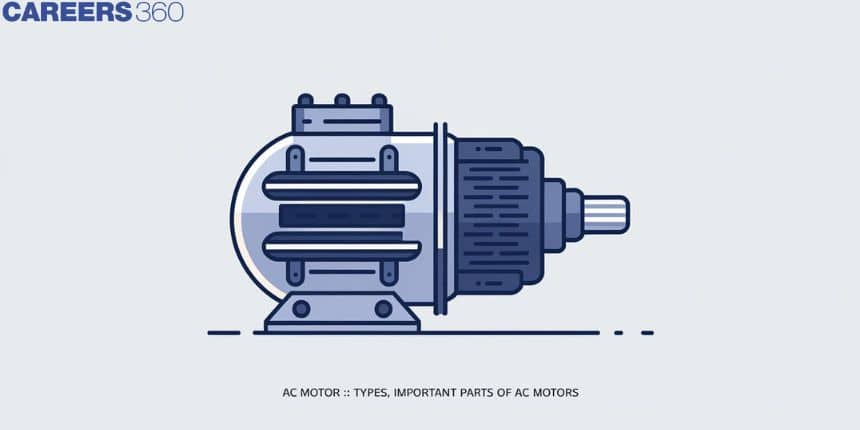AC Motor : Types, Important Parts Of AC Motors
An AC motor is an electric motor which works on the principle that when a current-carrying conductor is placed in an external magnetic field, it experiences a force. It is a device which converts alternating current into mechanical power which makes it an important component for electrical fans, refrigerators, mixers, washing machines and computers. It plays an important role in industry and also in a wide range of applications due to its practicality and ease of use. AC motors use alternating currents to produce rotation. The first AC induction motor was invented by Nikola Tesla in 1887.
This Story also Contains
- Important Parts Of AC Motors
- Different Types Of AC Motors
- Advantages Of AC Motors

Important Parts Of AC Motors
The rotor and the stator are two important parts of AC motors. Rotor: As the name suggests, it is a rotating part of the motor. It is a central component of a motor which is fixed to the shaft. The squirrel cage rotor is the most common type of rotor which is used in an AC motor. It is cylindrical in shape and it is generally made by stacking thin steel laminations.
Stator: This term is derived from the word stationary. The stator is the stationary part of the AC motor which delivers a rotating magnetic field to interact with the rotor.
Different Types Of AC Motors
There are two types of AC motors: Synchronous Motors and Induction Motors.
Synchronous Motor: The motor which runs at synchronous speed is called a synchronous motor and the constant speed at which the motor generates the electromotive force is called synchronous speed. In the rotating magnetic field, an electromagnet locks itself with the rotating magnetic field which means that these types of motors have fixed speeds. The synchronous speed of the AC motor is given by,
n_{s}=\frac{120f}{p}

Where n_{s} ![]() is the synchronous speed, p
is the synchronous speed, p  is the number of poles and f
is the number of poles and f ![]() is the frequency.
is the frequency.
The synchronous motor generally works with two electrical inputs. The rotor is provided with a direct current (DC) supply. So, it acts like a permanent magnet. The stator is provided with a 3-phase AC supply. The rotor of a synchronous motor produces a constant magnetic field and the stator produces a revolving magnetic field. Due to the attractive and repulsive force between the stator and rotor poles, the motor can not rotate in any direction. So, we can say that the synchronous motor is not self-starting.
Induction Motor: Induction motors always run slower than synchronous speed. That is why induction motors are also called asynchronous motors. The induction motor basically works on the principle of electromagnetic induction. Three-phase supply will be given to the stator. So, current will flow through the stator conductors and because of this, stator flux will rotate at a constant speed and constant amplitude comes into the picture.
Initially, the rotor is in standstill condition. Now, stator flux will link with the rotor conductors and due to this, an emf is induced in the rotor circuit. So, current will flow through the rotor conductors as the rotor circuit is short-circuited. Corresponding to this, rotor emf will come into the picture. To follow Lenz’s law, rotor emf will try to catch stator emf and due to this electromagnetic torque will be produced. Because of this, the rotor will start rotating and the relative speed will be reduced. The difference between the synchronous speed and the actual speed of the rotor is called the slip which is calculated by,
%s=\frac{N_{s}-N}{N_{s}}\times 100

Where N_{s} ![]() is the synchronous speed and N
is the synchronous speed and N ![]() is the actual speed of the rotor.
is the actual speed of the rotor.
Advantages Of AC Motors
There are different advantages of AC circuits such as
AC motors are versatile, safe and can be used for various applications.
AC motors are easy to control and flexible.
AC motors have many advantages over DC motors such as requiring minimal maintenance and being much safer.
Another advantage is that an AC source can be directly connected to AC motors.
These motors are suitable for applications requiring high performance and torque output.
Frequently Asked Questions (FAQs)
Based on their construction, there are two types of induction motors:
Slip ring induction motor
Squirrel cage induction motor
Following are a few advantages of squirrel cage induction motor:
Low cost and simple construction.
Less maintenance and can operate nearly at a constant speed.
It has a high overload capacity.
Following are a few advantages of a slip ring induction motor:
Smooth acceleration under heavy loads and no abnormal heating during starting.
It provides high starting torque with a low starting current.
Yes, DC motors are more efficient than AC motors. The efficiency of the motor depends upon different types of motor and parameters such as iron loss, copper loss and stray loss. AC motors have two components of current which are the active component and the reactive component. So, we can say that ac motors will have more copper loss. DC motors have no reactive component. So, the DC motor has a good power factor. Therefore, we can say that DC motors are more efficient.
AC motor can operate with single-phase or three-phase.AC supply is a main source while DC motor operates always only on single phase dc supply. We can control the speed of the AC motor by controlling supply frequency while the speed of the DC motor can be controlled by controlling the armature winding current.